
Food preservation includes processes that make food more resistant to microorganism growth and slow the oxidation of fats. This slows down the decomposition and rancidification process. Food preservation may also include processes that inhibit visual deterioration, such as the enzymatic browning reaction in apples after they are cut during food preparation. By preserving food, food waste can be reduced, which is an important way to decrease production costs and increase the efficiency of food systems, improve food security and nutrition and contribute towards environmental sustainability. For instance, it can reduce the environmental impact of food production.

A lenticel is a porous tissue consisting of cells with large intercellular spaces in the periderm of the secondarily thickened organs and the bark of woody stems and roots of gymnosperms and dicotyledonous flowering plants. It functions as a pore, providing a pathway for the direct exchange of gases between the internal tissues and atmosphere through the bark, which is otherwise impermeable to gases. The name lenticel, pronounced with an, derives from its lenticular (lens-like) shape. The shape of lenticels is one of the characteristics used for tree identification.

Browning is the process of food turning brown due to the chemical reactions that take place within. The process of browning is one of the chemical reactions that take place in food chemistry and represents an interesting research topic regarding health, nutrition, and food technology. Though there are many different ways food chemically changes over time, browning in particular falls into two main categories: enzymatic versus non-enzymatic browning processes.
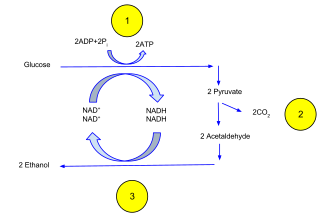
Ethanol fermentation, also called alcoholic fermentation, is a biological process which converts sugars such as glucose, fructose, and sucrose into cellular energy, producing ethanol and carbon dioxide as by-products. Because yeasts perform this conversion in the absence of oxygen, alcoholic fermentation is considered an anaerobic process. It also takes place in some species of fish where it provides energy when oxygen is scarce.

Modified atmosphere packaging (MAP) is the practice of modifying the composition of the internal atmosphere of a package in order to improve the shelf life. The need for this technology for food arises from the short shelf life of food products such as meat, fish, poultry, and dairy in the presence of oxygen. In food, oxygen is readily available for lipid oxidation reactions. Oxygen also helps maintain high respiration rates of fresh produce, which contribute to shortened shelf life. From a microbiological aspect, oxygen encourages the growth of aerobic spoilage microorganisms. Therefore, the reduction of oxygen and its replacement with other gases can reduce or delay oxidation reactions and microbiological spoilage. Oxygen scavengers may also be used to reduce browning due to lipid oxidation by halting the auto-oxidative chemical process. Besides, MAP changes the gaseous atmosphere by incorporating different compositions of gases.

The Braeburn is a cultivar of apple that is firm to the touch with a red/orange vertical streaky appearance on a yellow/green background. Its color intensity varies with different growing conditions.
Theoretical production ecology tries to quantitatively study the growth of crops. The plant is treated as a kind of biological factory, which processes light, carbon dioxide, water, and nutrients into harvestable parts. Main parameters kept into consideration are temperature, sunlight, standing crop biomass, plant production distribution, nutrient and water supply.
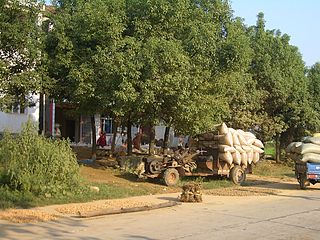
In agriculture, postharvest handling is the stage of crop production immediately following harvest, including cooling, cleaning, sorting and packing. The instant a crop is removed from the ground, or separated from its parent plant, it begins to deteriorate. Postharvest treatment largely determines final quality, whether a crop is sold for fresh consumption, or used as an ingredient in a processed food product.
Hermetic storage is a method of using sealed, airtight units to control moisture and insects in stored dry agricultural commodities. The hermetic storage restricts gas exchanges between the internal and external environments and the stored commodity, maintaining the initial levels of moisture and controlling pests by the lack of oxygen.

Soil respiration refers to the production of carbon dioxide when soil organisms respire. This includes respiration of plant roots, the rhizosphere, microbes and fauna.
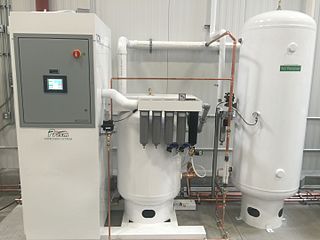
Modified atmosphere/modified humidity (MA/MH) packaging is a technology used to preserve the quality of fresh produce so that it can be sold to markets far away from where it is grown, extend the marketing period, and to help suppliers reduce food waste within the cold chain. Commercial examples of MA/MH include sea freight of Galia and cantaloupe melons from Central and South America to Europe and North America ; transport of white asparagus from fields in Peru to markets in Western Europe ; and trucking of cherries from orchards in Turkey to supermarkets in the UK.
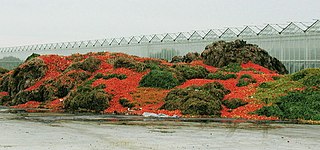
Post-harvest losses of vegetables and fruit occur at all points in the value chain from production in the field to the food being placed on a plate for consumption. Post-harvest activities include harvesting, handling, storage, processing, packaging, transportation and marketing.

Malting is the process of steeping, germinating and drying grain to convert it into malt. Germination and sprouting involve a number of enzymes to produce the changes from seed to seedling and the malt producer stops this stage of the process when the required enzymes are optimal. Among other things, the enzymes convert starch to sugars such as maltose, maltotriose and maltodextrines, hence the name malt.
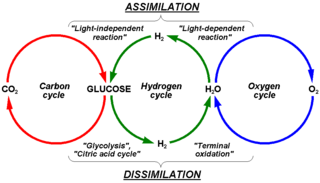
The carbon cycle is an essential part of life on Earth. About half the dry weight of most living organisms is carbon. It plays an important role in the structure, biochemistry, and nutrition of all living cells. Living biomass holds about 550 gigatons of carbon, most of which is made of terrestrial plants (wood), while some 1,200 gigatons of carbon are stored in the terrestrial biosphere as dead biomass.
Gas blending is the process of mixing gases for a specific purpose where the composition of the resulting mixture is specified and controlled. A wide range of applications include scientific and industrial processes, food production and storage and breathing gases.

Charles Eaves (1908–2006) was a Canadian scientist who extended the storage of apples by controlling levels of oxygen and carbon dioxide. He built the first controlled atmosphere (CA) storage in the Western Hemisphere in 1939 at Port Williams in Nova Scotia. After World War II his research at the Kentville Experimental Farm established storage methods that were adopted worldwide. He later advanced fruit storage in Turkey and Brazil for the United Nations and in 2000 was awarded an honorary doctorate by the Nova Scotia Agricultural College and Dalhousie University.
Grain storage on a subsistence farm is primarily based on minimizing grain loss. In modern agricultural practices there are methods of managing under 1% grain loss, but small subsistence farms can see 20% - 100% of grain loss. This causes starvation and an unstable food supply. Grain loss can be caused by mold growth, bugs, birds, or any other contamination.
Food and biological process engineering is a discipline concerned with applying principles of engineering to the fields of food production and distribution and biology. It is a broad field, with workers fulfilling a variety of roles ranging from design of food processing equipment to genetic modification of organisms. In some respects it is a combined field, drawing from the disciplines of food science and biological engineering to improve the earth's food supply.

Robert Mumford Smock was an American scientist and a professor at Cornell University. Known for his research for over two decades in the field of controlled atmosphere cold storage, which led to the use of controlled atmosphere rooms in the United States in the 1950s and later throughout the world. The method he developed made it possible to extend the shelf life of fruits, especially apples throughout the year.
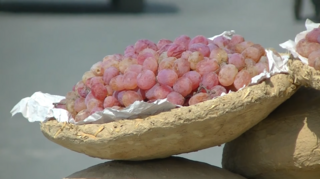
Kangina is the traditional Afghan technique of preserving fresh fruit, particularly grapes, in airtight discs formed from mud and straw. The centuries-old technique is indigenous to Afghanistan's rural center and north, where remote communities that cannot import fresh fruit eat kangina-preserved fresh grapes throughout the winter, and merchants use kangina to safely store and transport grapes for sale at market. Grapes preserved using kangina in modern Afghanistan are typically of the thick-skinned Taifi or Kishmishi varieties, which are harvested later in the season and remain fresh in the mud vessels for up to six months.















